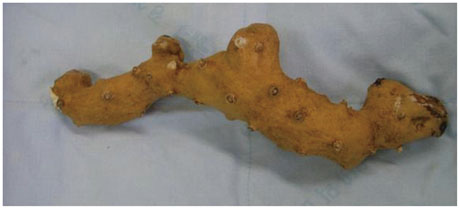Yonsei Med J.
2015 Jan;56(1):304-306. 10.3349/ymj.2015.56.1.304.
A Case of Life-Threatening Acute Kidney Injury with Toxic Encephalopathy Caused by Dioscorea quinqueloba
- Affiliations
-
- 1Division of Cardiology, Department of Internal Medicine, Yonsei University College of Medicine, Seoul, Korea. cby6908@yuhs.ac
- KMID: 2352822
- DOI: http://doi.org/10.3349/ymj.2015.56.1.304
Abstract
- Some herbal medications induce acute kidney injury. The acute kidney injuries caused by herbal medications are mild and commonly treated by palliative care. A 51-years-old man who drank the juice squeezed from the raw tubers of Dioscorea quinqueloba (D. quinqueloba) was admitted with nausea, vomiting and chilling. He developed a seizure with decreased level of consciousness. He was diagnosed with acute kidney injury, which was cured by continuous venovenous hemodialfiltration. Non-detoxified D. quinqueloba can cause severe acute kidney injury with toxic encephalopathy. It is critical to inform possible adverse effects of the medicinal herbs and to implement more strict regulation of these products.
MeSH Terms
Figure
Reference
-
1. Vanherweghem JL. Nephropathy and herbal medicine. Am J Kidney Dis. 2000; 35:330–332.
Article2. De Smet PA. Herbal remedies. N Engl J Med. 2002; 347:2046–2056.
Article3. Gabardi S, Munz K, Ulbricht C. A review of dietary supplement-induced renal dysfunction. Clin J Am Soc Nephrol. 2007; 2:757–765.
Article4. Isnard Bagnis C, Deray G, Baumelou A, Le Quintrec M, Vanherweghem JL. Herbs and the kidney. Am J Kidney Dis. 2004; 44:1–11.
Article5. Mengesha WA, Demissew S, Fay MF, Smith RJ, Nordal I, Wilkin P. Genetic diversity and species delimitation in the cultivated and wild Guinea yams (Dioscorea spp.) from Southwest Ethiopia as determined by AFLP (amplified fragment length polymorphism) markers. Genet Resour Crop Evol. 2013; 60:1365–1375.
Article6. Steenkamp V, Stewart MJ. Nephrotoxicity associated with exposure to plant toxins, with particular reference to Africa. Ther Drug Monit. 2005; 27:270–277.
Article7. Kim CS, Kim SM, Choi JS, Bae EH, Kim SW. Dioscorea quinqueloba induces acute kidney injury. Clin Toxicol (Phila). 2012; 50:80.
Article8. Jha V, Rathi M. Natural medicines causing acute kidney injury. Semin Nephrol. 2008; 28:416–428.
Article9. Pirmohamed M. Herbal medicines. Postgrad Med J. 2003; 79:489.
Article10. Yang CS, Lin CH, Chang SH, Hsu HC. Rapidly progressive fibrosing interstitial nephritis associated with Chinese herbal drugs. Am J Kidney Dis. 2000; 35:313–318.
Article11. Tovar RT, Petzel RM. Herbal toxicity. Dis Mon. 2009; 55:592–641.
Article12. Tchabi A, Burger S, Coyne D, Hountondji F, Lawouin L, Wiemken A, et al. Promiscuous arbuscular mycorrhizal symbiosis of yam (Dioscorea spp.), a key staple crop in West Africa. Mycorrhiza. 2009; 19:375–392.
Article13. Bhandari MR, Kawabata J. Bitterness and toxicity in wild yam (Dioscorea spp.) tubers of Nepal. Plant Foods Hum Nutr. 2005; 60:129–135.
Article14. Wojcikowski K, Wohlmuth H, Johnson DW, Gobe G. Dioscorea villosa (wild yam) induces chronic kidney injury via pro-fibrotic pathways. Food Chem Toxicol. 2008; 46:3122–3131.
Article
- Full Text Links
- Actions
-
Cited
- CITED
-
- Close
- Share
- Similar articles
-
- Dioscorea Quinqueloba-Induced Tubulointerstitial Nephritis
- Symptomatic Hypocalcemia Associated with Dioscorea tokoro Toxicity
- Hyperkalemia in a patient with rhabdomyolysis and compartment syndrome: A case report
- A Case of Acute Toxic Hepatitis and Acute Kidney Injury after Ingestion of Ulmus davidiana var. japonica Extracts
- Severe Hypophosphatemia-Induced Acute Toxic-Metabolic Encephalopathy in Continuous Renal Replacement Therapy



